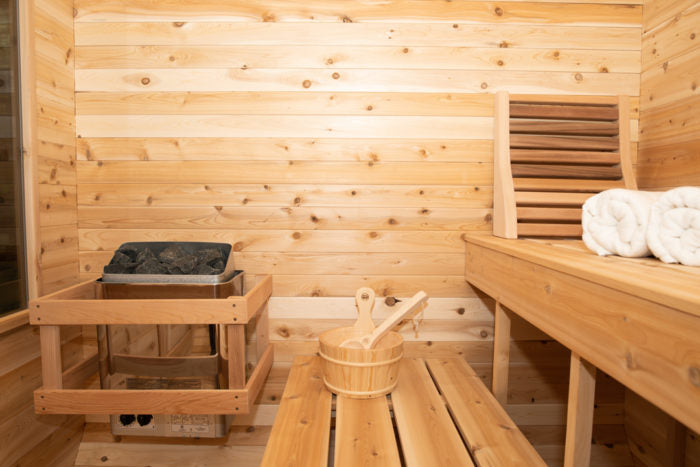Not known Facts About Traditional Sauna
Not known Facts About Traditional Sauna
Blog Article
The Only Guide to Traditional Sauna
Table of Contents3 Simple Techniques For Traditional SaunaTraditional Sauna Things To Know Before You BuyTraditional Sauna Things To Know Before You Get ThisUnknown Facts About Traditional SaunaAn Unbiased View of Traditional Sauna
Energy savings is something to think about for individuals that plan on using their sauna regularly. For a conventional sauna, bathers usually require to await 30-40 mins for the area to preheat prior to entering. Infrared saunas, on the other hand, generally reach their perfect temperature in about 15 mins.That suggests that in an infrared sauna, bathers can start enjoying their sauna quickly. One difference between the two types of sauna that is often overlooked is the social experience.

The Main Principles Of Traditional Sauna

Try a sauna today and find some of the impressive benefits on your own!.

Aspects such as warm resistance, wanted degree of cleansing, and general wellness ought to be taken into consideration when choosing which type of sauna to utilize. Infrared saunas are a kind of sauna that make use of infrared light to heat up the body directly, as opposed to heating the air around the body like traditional saunas.
Traditional Sauna Can Be Fun For Anyone
The temperature in an infrared sauna is commonly reduced than in a traditional sauna, with temperature levels ranging from 120F to 150F. Infrared saunas supply a variety of benefits that make them an attractive choice for those aiming to improve their wellness and well-being. Some of the advantages of infrared saunas include: Infrared saunas utilize reduced temperatures than conventional saunas, which can make them much more comfortable for those that discover heats tough to endure.
Infrared saunas have been shown to assist the body get rid of toxic substances through sweating. Sweating can likewise aid to enhance skin health by eliminating impurities and dead skin cells.
The warmth created by infrared saunas can help to increase blood flow and improve blood circulation. This can help to lower inflammation, advertise healing, and boost general cardio wellness. Infrared saunas have been revealed to help in reducing stress and advertise relaxation. This can aid to boost state of mind, reduce anxiety, and boost total psychological health.
With their lower temperatures, deep infiltration, and variety of health benefits, infrared saunas are a great means to unwind, relax, and boost your total health. Traditional completely dry saunas have been around for centuries and are still prominent today. They are commonly heated with timber, gas, or electricity and have reduced moisture levels.
Traditional Sauna Fundamentals Explained
There are numerous advantages to utilizing a conventional dry sauna. Below are a few: Relaxation: The high temperature level and reduced moisture in conventional completely dry saunas can aid relax the muscular tissues and reduce anxiety levels. Detoxing: Sweating in a sauna can aid remove toxic substances from the body, which can enhance general health and wellness.
When it concerns saunas, there are two major types of home heating approaches: traditional and infrared. Traditional saunas utilize heated air to heat the body, while infrared saunas make use of infrared radiation official source to pass through the skin and warmth the body from within. One YOURURL.com of the main distinctions between the 2 approaches is the type of warm they produce.
Typical saunas heat the air, which after that heats the body via convection. Infrared saunas, on the various other hand, warm the body directly through radiation.
In terms of power performance, infrared saunas are generally extra efficient than typical saunas since they need much less power to operate. They additionally heat up faster, so they can be made use of for much shorter sessions. Traditional Sauna. When it comes to the impacts on the body, both sorts of saunas have been shown to have advantages
The Main Principles Of Traditional Sauna
Infrared saunas have been revealed to have comparable advantages, along with potentially aiding with cleansing, skin health, and immune function. On the whole, the choice in between a typical or infrared sauna boils down to personal preference and private needs. Traditional saunas might be better for those who like greater temperatures and a more extreme sweat action, while infrared saunas might be better for those that want a more gentle and reliable heat therapy.
Both types of saunas use special benefits and drawbacks that ought to be taken into consideration before making a choice. The selection in between an infrared sauna and a conventional dry sauna mainly relies on personal choice and the desired advantages. Those that choose a more comfortable, lower temperature environment might favor an infrared sauna, while those that are looking for extreme warm and a conventional sauna experience may favor a traditional completely dry sauna.
Below are some safety tips to maintain in mind when making use of infrared and conventional dry saunas:: Saunas can trigger excessive sweating, leading to dehydration. It is very this hyperlink important to consume alcohol lots of water before, during, and after sauna sessions to remain hydrated.: It is suggested to limit sauna sessions to 20-30 mins to prevent getting too hot and dehydration.
Report this page